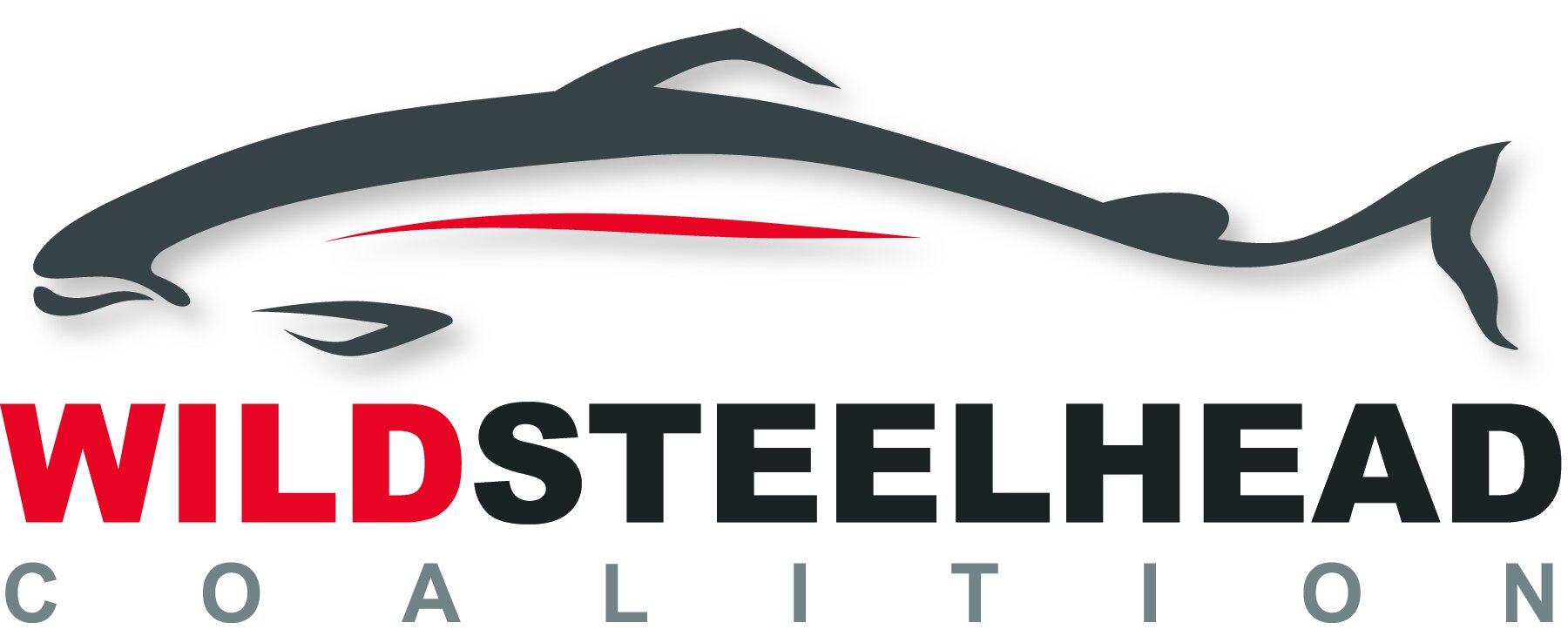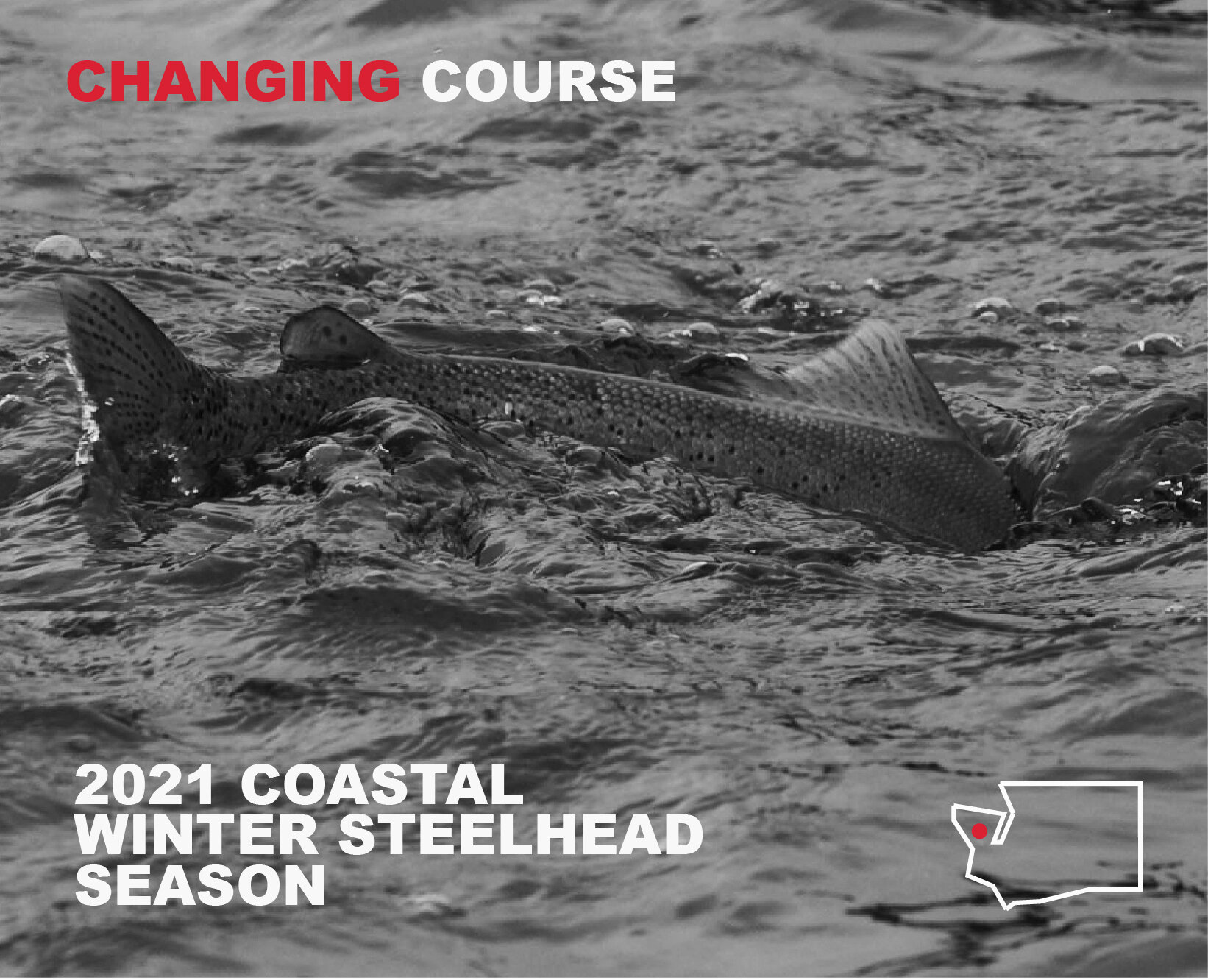A Change of Course: Washington Coast and Olympic Peninsula Winter Steelhead Season Rules Finalized
After weeks of public debate and anxiety within the steelhead angling community, Washington Department of Fish & Wildlife (WDFW) fishery managers have announced their emergency conservation rules for the upcoming winter steelhead season on Coastal and Olympic Peninsula rivers.
While partial and/or complete sportfishing closures were considered, the Department is proceeding with a plan that bans fishing from boats and the use of bait, requires the use of single-point barbless hooks, and bans rainbow trout retention to protect juvenile steelhead. Seasons will close a few weeks earlier than previous years, with some variability among watersheds. These new regulations take effect on Monday, December 14 and run until further notice.
Details on seasons for affected rivers are listed here: WDFW Conservation Rules Implemented on Coastal Tributaries
The WDFW has also posted a great document explaining the metrics and rationale they used to develop the emergency regulations. Anglers can access this resource here: Changes to the Coastal Steelhead Season
A New Paradigm
This season’s conservation rules represent a massive change to the status quo on the Coast and Olympic Peninsula. Some anglers believe they go too far and others believe they don’t go far enough. Arguments are raging within the angling community as guides and individual anglers grapple with the economic and fishery implications of the new rules.
While these emergency regulations are a profound shock to the system, we must keep a simple fact in mind: Something needed to give. Most years, not nearly enough wild steelhead were reaching their spawning grounds to sustain, let alone recover, their declining populations.
Steelhead numbers across the coast and Olympic Peninsula have been falling for decades. Iconic rivers like the Hoh, Queets, Bogachiel, Chehalis and Humptulips have often missed escapement goals. Rivers like the Calawah and Sol Duc, though celebrated as relative strongholds, have seen their runs decline. All the while, as steelhead stocks continued to slip, pressure on the remaining fish only increased as more and more anglers - encouraged by sportfishing media, brands, travel companies, and outfitters - visited these watersheds each winter. As sheer numbers and the subsequent impacts grew among the crowds of recreational anglers, commercial tribal fisheries continued to harvest winter steelhead along much of the coast. Whenever the run size forecasts used to determine commercial harvest and angler mortality allocations turned out to be too low, or ocean conditions became unfavorable and fewer smolts survived, the combined impacts of these fisheries compounded to push steelhead stocks further into decline.
The writing has been on the wall for years. We can debate the timing and details of the recently finalized regulations, but it is unacceptable to deny that drastic, emergency steps were required. Fishery Managers should be commended for making the tough decisions necessary to change course and for communicating the dire situation to the public. The Wild Steelhead Coalition wants to offer our appreciation to the biologists and managers who have taken serious, consequential steps to protect these incredible fish for the future. We hope this moment marks a true paradigm shift in fishery management for Washington’s coastal watersheds and leads to the longer term thinking required for true wild steelhead recovery in these rivers.
The Washington coast has exceptional remaining habitat, salvageable populations of wild stocks, and passionate advocates. Preserving these precious wild steelhead runs for the future will require new and unprecedented collaboration between agencies, tribes and sport anglers, but we should all be working together to make this magnificent region a beacon for wild steelhead conservation for the 21st Century.
The Upcoming Winter Season
To be honest, when WDFW announced the need to dramatically curtail the impact of recreational angling in coastal waters for conservation purposes, we had expected the final emergency regulation regime would combine short seasons and/or complete sport fishing closures. Love them or hate them, there is no denying that closures are the simplest to enforce, obviously limit impacts because it stops all fishing, and are the most democratic option because all anglers are kept off the water no matter their preferred angling technique or access to boats, rafts, or other equipment.
Instead, the Department has opted for coast-wide emergency rule changes they believe effectively strike a balance between allowing a longer fishing season and a measurable reduction in wild steelhead caught and handled by anglers. It is a controversial plan with immediate impacts on the angling status quo. Citing years of creel survey data, the Department clearly demonstrates that anglers fishing from boats catch five times the number of steelhead as wading anglers. This makes a great deal of sense, and is obvious to any angler, but it is helpful to see the disparity presented so clearly in the data. Fishing from boats provides anglers with access to every pool, deep slot, or mid-river holding water throughout a river system. The fish have no sanctuary to rest undisturbed. The dramatic increase in the use of rafts in recent years means that even upper sections of rivers, especially when the water gets low, continue to receive immense amounts of angling pressure late into the season.
While we are concerned about the perception that differing subsets of the angling public are winners and losers in this scenario, and the need for a nuanced, river-by-river regulatory regime in the long run, we hope the WDFW’s emergency rules prove effective and redd surveys show that more wild steelhead were able to reach the spawning grounds this Spring.
One positive element should be acknowledged: The WDFW’s effort to keep anglers on the water, even as they adjust to emergency rules, still lets these advocates for our fisheries visit coastal communities, rent hotel rooms and cabins, spend money on groceries and at restaurants, and hire guides to take them fishing. If a complete closure had been announced instead, all of this critical economic activity would immediately disappear.
In the meantime, we are waiting for announcements concerning the rules for the Queets River, which is managed by the Federal staff of Olympic National Park. The Queets is projected to miss escapement goals again this year as pre-season estimates show it coming up short by over 600 fish. It should probably be closed completely to angling.
We are also waiting for final agreements between co-managers establishing the parameters for commercial gillnet fisheries in coastal watersheds, but are optimistic that some inspiring collaboration has occurred during negotiations. While final details aren’t public yet, we are encouraged by the WDFW’s statement in their online resource document explaining that “Tribal governments are also reducing their fishing times to support conservation objectives. These actions expand on actions the department and tribal co-managers took in 2019 to close steelhead fishing in mid-February on the Chehalis and Willapa rivers.”
This is promising news. Sport anglers are being asked to reduce their impact on wild steelhead populations. We hope tribes see and appreciate this and we also hope recreational anglers acknowledge that the tribes are also making sacrifices to their legal fishery. After all, we all share the same goals of abundance: We all want more fish to reach the spawning gravel and we want wild steelhead on the coast to thrive long into the future.
We know the Department’s emergency rules will create friction and crowds on the banks of these popular rivers. We hope anglers of all types can recognize the severity of the situation and err towards principles of river etiquette to find equitable ways to share the water this winter.
Next Steps for the Washington Coast
While the upcoming season will be governed by emergency conservation rules, these rivers and their wild fish still require new, viable long-term management regimes to recover their populations and continue to provide recreational angling and commercial fishing opportunities into the future. The fact is, steelhead populations along the coast and Olympic Peninsula are hovering at grim levels that could easily trigger an Endangered Species Listing if they slip any further. This would end fishing of any kind for the foreseeable future. This looming threat of collapse should motivate every stakeholder up and down the coast to come to the table and build a new path forward together. The time for delay is over.
The Wild Steelhead Coalition is deeply committed to the watersheds and wild fish of Washington’s coast. We were founded twenty years ago when the famous wild winter steelhead runs of Puget Sound finally collapsed. We know how this story ends if we fish the coastal rivers down to nothing. We want to learn the lessons of the past and do things better this time before it is too late.
There is a great deal of work to be done and tough decisions that still need to be made. We hope this Winter’s emergency regulations prove effective and an opportunity to evaluate and refine the rules can be done further in advance of next year’s season.
In the end, we hope our communities can come together and be proud of the shared effort to preserve and recover these astounding wild steelhead rivers. This is a challenging time for wild steelhead, and wild steelhead anglers, but we believe our generation is up to the task to truly change direction towards viable recovery, and a thriving future, for Washington’s amazing coast and Olympic Peninsula steelhead rivers.
Additional Resources





